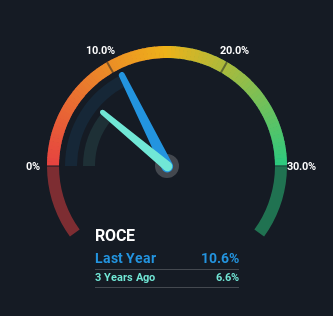- South Africa
- /
- Professional Services
- /
- JSE:ADR
Capital Allocation Trends At Adcorp Holdings (JSE:ADR) Aren't Ideal
When we're researching a company, it's sometimes hard to find the warning signs, but there are some financial metrics that can help spot trouble early. Businesses in decline often have two underlying trends, firstly, a declining return on capital employed (ROCE) and a declining base of capital employed. This combination can tell you that not only is the company investing less, it's earning less on what it does invest. Having said that, after a brief look, Adcorp Holdings (JSE:ADR) we aren't filled with optimism, but let's investigate further.
What Is Return On Capital Employed (ROCE)?
For those who don't know, ROCE is a measure of a company's yearly pre-tax profit (its return), relative to the capital employed in the business. To calculate this metric for Adcorp Holdings, this is the formula:
Return on Capital Employed = Earnings Before Interest and Tax (EBIT) ÷ (Total Assets - Current Liabilities)
0.11 = R189m ÷ (R3.0b - R1.2b) (Based on the trailing twelve months to August 2023).
So, Adcorp Holdings has an ROCE of 11%. That's a relatively normal return on capital, and it's around the 13% generated by the Professional Services industry.
View our latest analysis for Adcorp Holdings

Above you can see how the current ROCE for Adcorp Holdings compares to its prior returns on capital, but there's only so much you can tell from the past. If you'd like to see what analysts are forecasting going forward, you should check out our free analyst report for Adcorp Holdings .
What Does the ROCE Trend For Adcorp Holdings Tell Us?
We are a bit anxious about the trends of ROCE at Adcorp Holdings. Unfortunately, returns have declined substantially over the last five years to the 11% we see today. In addition to that, Adcorp Holdings is now employing 37% less capital than it was five years ago. When you see both ROCE and capital employed diminishing, it can often be a sign of a mature and shrinking business that might be in structural decline. If these underlying trends continue, we wouldn't be too optimistic going forward.
On a side note, Adcorp Holdings' current liabilities are still rather high at 40% of total assets. This can bring about some risks because the company is basically operating with a rather large reliance on its suppliers or other sorts of short-term creditors. While it's not necessarily a bad thing, it can be beneficial if this ratio is lower.
Our Take On Adcorp Holdings' ROCE
In summary, it's unfortunate that Adcorp Holdings is shrinking its capital base and also generating lower returns. It should come as no surprise then that the stock has fallen 64% over the last five years, so it looks like investors are recognizing these changes. Unless there is a shift to a more positive trajectory in these metrics, we would look elsewhere.
Adcorp Holdings does come with some risks though, we found 4 warning signs in our investment analysis, and 1 of those shouldn't be ignored...
For those who like to invest in solid companies, check out this free list of companies with solid balance sheets and high returns on equity.
New: Manage All Your Stock Portfolios in One Place
We've created the ultimate portfolio companion for stock investors, and it's free.
• Connect an unlimited number of Portfolios and see your total in one currency
• Be alerted to new Warning Signs or Risks via email or mobile
• Track the Fair Value of your stocks
Have feedback on this article? Concerned about the content? Get in touch with us directly. Alternatively, email editorial-team (at) simplywallst.com.
This article by Simply Wall St is general in nature. We provide commentary based on historical data and analyst forecasts only using an unbiased methodology and our articles are not intended to be financial advice. It does not constitute a recommendation to buy or sell any stock, and does not take account of your objectives, or your financial situation. We aim to bring you long-term focused analysis driven by fundamental data. Note that our analysis may not factor in the latest price-sensitive company announcements or qualitative material. Simply Wall St has no position in any stocks mentioned.
About JSE:ADR
Adcorp Holdings
Provides workforce solutions in South Africa and Australia.
Flawless balance sheet, good value and pays a dividend.
Market Insights
Community Narratives



